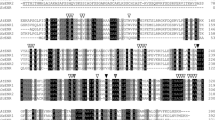Abstract
We used a PCR-based library screening method to isolate a 1.4 kb pea leaf cDNA encoding ornithine transcarbamoylase (OTCase). The cDNA contains a single major ORF of 375 amino acids whose deduced sequence exhibits a high degree of homology with other OTCases. The predicted molecular mass of 41 361 Da for this protein is approximately the 40 kDa size of the polypeptide that is immunoprecipitated with OTCase antibody afterin vitro translation of pea leaf mRNA.In vivo, OTCase occurs as a trimer of identical 36.5 kDa polypeptides, suggesting that this enzyme is synthesized as a cytosolic precursor protein. Southern blot analysis indicates that multiple OTCase genes occur in pea. An abundant 1.4 kb transcript is seen in northern blots of total RNA isolated from the leaves and roots of light- and dark-grown pea seedlings.
Similar content being viewed by others
References
Acaster MA, Scott-White S, Weitzman PDJ: Carbamoyltransferase reactions in plants. A survey for enzymatic diversity and the potential for herbicidal activity of transition state analogue inhibitors. J Exp Bot 40: 1121–1125 (1989).
Amaravadi L, King MW: A rapid and efficient nonradioactive method for screening recombinant DNA libraries. BioTechniques 16: 98–103 (1994).
Baur H, Stalon V, Falmagne P, Luethi E, Haas D: Primary and quaternary structure of the catabolic ornithine carbamoyltransferase fromPseudomonas aeruginosa. Extensive sequence homology with the anabolic ornithine carbamoyltransferases ofEscherichia coli. Eur J Biochem 166: 11–17 (1987).
deRuiter H, Kolloffel C: Properties of ornithine carbamoyl-transferase fromPisum sativum L. Plant Physiol 77: 695–699 (1985).
Don RH, Cox PT, Wainwright BJ, Baker K, Mattick JS: "Touchdown" PCR to circumvent spurious priming during gene amplification. Nucl Acids Res 19: 4008 (1991).
Eckenrode VK, Arnold J, Meagher RB: Comparison of the nucleotide sequence of soybean 18S rRNA with the sequences of other small-subunit rRNAs. J Mol Evol 21: 259–269 (1985).
Eid S, Waly Y, Abdelal AT: Separation and properties of two ornithine carbamoyltransferases fromPisum sativum seedlings. Phytochemistry 13: 99–102 (1974).
Glenn E, Maretzki A: Properties and subcellular distribution of two partially purified ornithine transcarbamylases in cell suspensions of sugarcane. Plant Physiol 60: 122–126 (1977).
Horwich AL, Fenton WA, Williams KR, Kalousek F, Kraus JP, Doolittle RF, Konigsberg W, Rosenberg LE: Structure and expression of a complementary DNA for the nuclear coded precursor of human mitochondrial ornithine transcarbamylase. Science 224: 1068–1074 (1984).
Huygen R, Crabeel M, Glansdorff N: Nucleotide sequence of theARG3 gene of the yeastSaccharomyces cerevisiae encoding ornithine carbamoyltransferase. Comparison with other carbamoyltransferases. Eur J Biochem 166: 371–377 (1987).
Itoh Y, Soldati L, Stalon V, Falmagne P, Terawaki Y, Leisinger T, Haas D: Anabolic ornithine carbamoyl-transferase ofPseudomonas aeruginosa: nucleotide sequence and transcriptional control of theargF structural gene. J Bact 170: 2725–2734 (1988).
Keegstra K, Olsen LJ, Theg SM: Chloroplastic precursors and their transport across the envelope membranes. Annu Rev Plant Physiol Plant Mol Biol 40: 471–501 (1989).
Kraus JP, Hodges PE, Williamson CL, Horwich AL, Kalousek F, Williams KR, Rosenberg LE: A cDNA clone for the precursor of rat mitochondrial omithine transcarbamylase: comparison of rat and human leader sequences and conservation of catalytic sites. Nucl Acids Res 13: 943–952 (1985).
Kuo LC, Caron C, Lee S, Herzberg W: Zn2+ regulation of ornithine transcarbamoylase. II. Metal binding site. J Mol Biol 211: 271–280 (1990).
Lovatt CJ, Cheng AH: Aspartate carbamyltransferase. Site of end-product inhibition of the orotate pathway in intact cells ofCucurbita pepo. Plant Physiol 75: 511–515 (1984).
Moore AL, Wood CK, Watts FZ: Protein import into plant mitochondria. Annu Rev Plant Physiol Plant Mol Biol 45: 545–575 (1994).
Mosqueda G, Van denBroek G, Saucedo O, Bailey AM, Alvarez-Morales A, Herrera-Estrella L: Isolation and characterization of the gene fromPseudomonmas syringae pv.phaseolicola encoding the phaseolotoxin-insensitive ornithine carbamoyltransferase. Mol Gen Genet 222: 461–466 (1990).
Nichols HF, Slocum RD: Putrescine carbamoyltransferase activity in pea is associated with the ornithine carbamoyltransferase polypeptide and is not involved in putrescine synthesis under physiological conditions. Plant Growth Regul 12: 237–244 (1993).
Slocum RD, Williamson CL, Poggenburg CA, Lynes MA: Immunogical characterization of plant ornithine transcarbamylases. Plant Physiol 192: 1205–1210 (1990).
Slocum RD, Richardson DP: Purification and characterization of ornithine transcarbamylase from pea (Pisum sativum L.) Plant Physiol 96: 262–268 (1991).
Templeton MD, Sullivan PA, Shepherd MG: Phaseolotoxin-insensitive L-ornithine transcarbamoylase fromPseudomonas syringae pv.phaseolicola. Physiol Mol Plant Path 29: 393–403 (1986).
Thompson JF: Arginine synthesis, proline synthesis, and related processes. In: Miflin BJ (ed) The Biochemistry of Plants, pp. 375–402. Academic Press, New York (1980).
VanVliet F, Cunin R, Jacobs A, Piette J, Gigot D, Lauwereys M, Pierard A, Glansdorff N: Evolutionary divergence of genes for ornithine and aspartate carbamoyltransferases-complete sequence and mode of regulation of theEscherichia coli argF gene; comparison ofargF withargI andpyrB. Nucl Acids Res 12: 6277–6289 (1984).
Wild JR, Wales ME: Molecular evolution and genetic engineering of protein domains involving aspartate transcarbamoylase. Annu Rev Microbiol 44: 193–218 (1990).
Williamson CL, Slocum RD: Molecular cloning and evidence for osmoregulation of the Δ1-pyrroline-5-carboxylate reductase (proC) gene in pea (Pisum sativum L.) Plant Physiol 100: 1464–1470 (1992).
Williamson CL, Slocum RD: Molecular cloning and characterization of thepyrB1 andpyrB2 genes encoding aspartate transcarbamoylase in pea (Pisum sativum L.). Plant Physiol 105: 377–384 (1994).
Author information
Authors and Affiliations
Rights and permissions
About this article
Cite this article
Williamson, C.L., Lake, M.R. & Slocum, R.D. Isolation and characterization of a cDNA encoding a pea ornithine transcarbamoylase (argF) and comparison with other transcarbamoylases. Plant Mol Biol 31, 1087–1092 (1996). https://doi.org/10.1007/BF00040826
Received:
Accepted:
Issue Date:
DOI: https://doi.org/10.1007/BF00040826




